Author: Nicholas Garcia Messari Research Analyst, Translated by OneBlock+
Recently, Messari Crypto released a data report on the status of Polkadot in Q1 2024. OneBlock+ has sorted out the core data and content of this report for you, helping every reader to deeply understand the current status and future trends of Polkadot ecosystem development from the detailed data report, and looking forward to ushering in new breakthroughs in the Polkadot ecosystem in 2024 with every developer.
Key Points
The Polkadot ecosystem's daily active addresses hit an all-time high of 514,000, up 48% month-on-month and 192% in 6 months, with Moonbeam still the leading parachain.
XCM cross-chain message consensus increased by 94% month-on-month and 314% in 6 months; also in the past year, XCM cross-chain message consensus has increased every quarter.
Gavin Wood shared proposals for the future development of Polkadot and introduced the JAM Chain - merging Ethereum and Polkadot functions, aimed at improving the scalability of the on-chain ecosystem while maintaining resilience.
Referendum 457 seeks to diversify Polkadot's financial management with USDT and USDC and allow financial proposals to be denominated in stablecoins. This referendum aims to convert 340W DOT using HydraDX's DCA function.
Basic Introduction to Polkadot
Polkadot is a decentralized blockchain computing platform that serves as the base layer for other parachains for verification and shared security. Polkadot is built using the Substrate blockchain development framework. In addition, Polkadot's base layer is called the Relay Chain, which utilizes the Nominated Proof of Stake (NPoS) consensus mechanism, and its state machine is compiled to WebAssembly (Wasm). The core function of the Polkadot Relay Chain is to verify and provide security for its parachains. Parachains are added to the Relay Chain through a parachain slot auction. Currently, the auction process is a candle auction that lasts for one week. During this period, potential parachains "bid" DOT tokens to obtain a parachain slot. However, this model will be updated in 2024.
Finally, parachains on Polkadot can communicate with each other through the Cross-Consensus Message Format (XCM). XCM is a message format that standardizes messages between Polkadot cross-chains, allowing for greater interoperability.
Polkadot 2024 Q1
Overview of Ecological Development
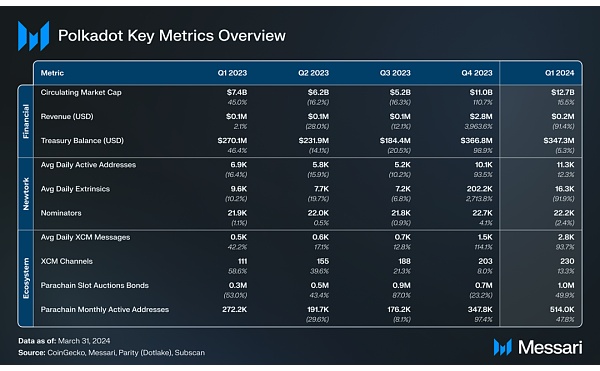
Financial Analysis
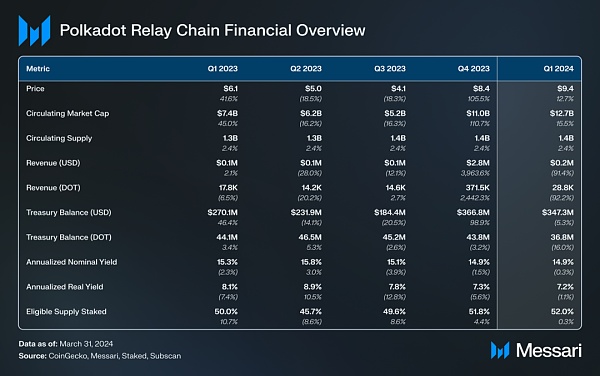
Market Value:
Ranking of Top 16 Crypto Projects
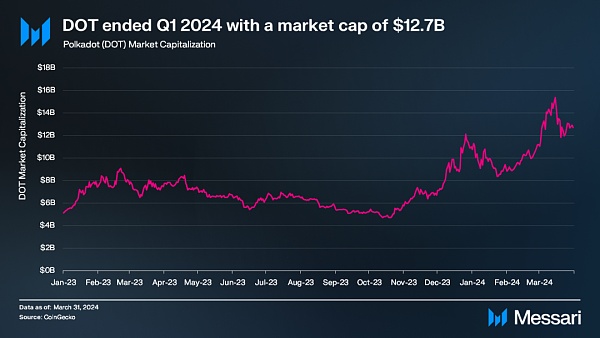
In the fourth quarter of 2023, DOT's circulating market value increased by 111% over the previous year to $8.4 billion. Following the rapid growth in the first quarter of 2024, DOT's circulating market value further increased by 16% to $12.7 billion; DOT rose 270% from its lowest point during the bear market. At the end of this quarter, Polkadot ranked 16th among all crypto protocols, and DOT was still 80% lower than its historical high of $55.5 billion on November 8, 2021.
Total Revenue:
Inscription drives continued growth of extrinsics
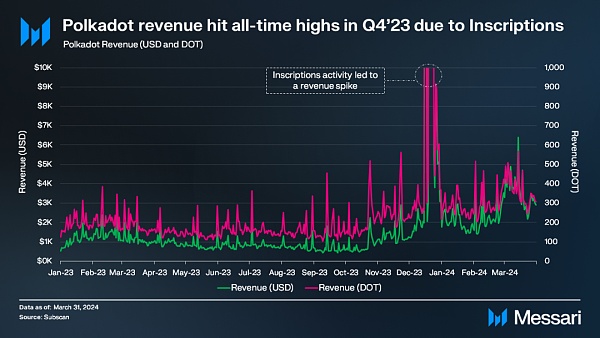
In the fourth quarter of 2023, Polkadot's total revenue was $2.8 million, a 2,880% increase from the previous quarter. The surge in revenue was mainly attributed to the Polkadot inscription drive in late December, with extrinsics rising sharply. In the first quarter of 2024, the revenue indicator fell sharply on a month-on-month basis, with revenue of only $241,000 (-91% month-on-month) and revenue (DOT) of $28,800 (-92% month-on-month). A more accurate comparison to Q3 2023 is that revenue (USD) grew 249% and revenue (DOT) grew 97% on that baseline. It is worth noting that Polkadot’s revenue is relatively low due to the network’s structural design. Supply: Keeping DOT Liquid Polkadot’s token, DOT, serves three main purposes: governance, staking, and parachain bonding. As of the end of Q1 2024, Polkadot’s staking rate was 52%. With an inflationary monetary policy and no maximum supply, DOT’s monetary policy is determined by its compliance with an ideal staking rate, which takes into account enough backed DOTs to prevent possible security compromises while maintaining liquidity for the native token. If the staking amount is lower than the ideal rate, the staking rewards for nominators will increase, encouraging more staking. Conversely, if the staking rate exceeds the ideal value, the staking rewards will decrease.
Treasury:
A diversified management mechanism is taking shape
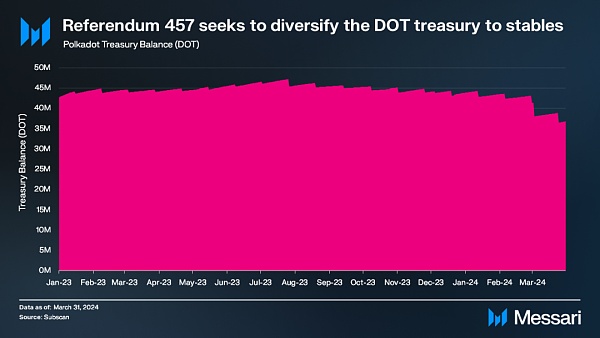
The funds for the Polkadot Treasury come from block rewards, validator penalties, transaction fees and staking efficiency. Funds are stored in a system account and allocated to a 24-day spending cycle, and unused funds will be destroyed at a rate of 1%. It is worth noting that all treasury expenditures are automatically executed on the chain to ensure transparency and accountability mechanisms.
Polkadot Referendum 457 seeks to diversify the Polkadot treasury with USDT and USDC and allow for treasury proposals denominated in stablecoins. This referendum aims to achieve a goal of converting 3.4 million DOTs (1.7 million UDST and USDC per transaction) over the next year by using HydraDX's DCA feature for daily trade conversions (100 USDT &USDC per trade, totaling 36,000 USDT &USDC per day). In addition, the referendum will send 5,000 DOTs to HydraDX as a prepayment for trading fees and leverage HydraDX's pure proxy account for swaps. The acquired USDT and USDC will then be sent to the Polkadot Treasury regularly in the form of 5,000 UDST and 5,000 USDC. The treasury denominated in stablecoins will add predictability to the Polkadot Treasury. As of the end of the first quarter of 2024, the Polkadot Treasury held approximately 37 million DOTs ($347 million). Compared to the previous quarter, USD and DOT fell by 5.3% and 16%, respectively.
Network Analysis
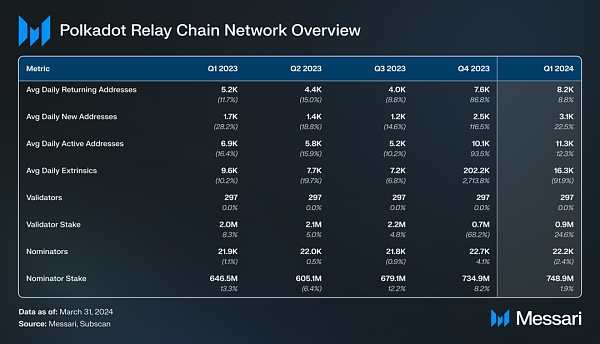
Usage:
Governance activities lead to an increase in relay chain account activity
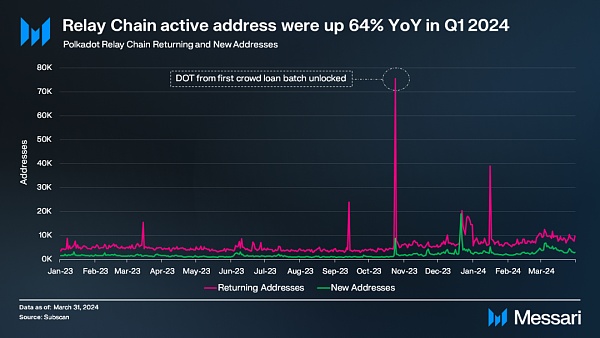
Polkadot relay chain has several main functions, including protecting and connecting parachains. Therefore, its end users usually trade and use the network across different parachains. Today, the relay chain supports some end-user functionality, including token transfers, staking, validator elections, governance voting, and participating in parachain slot auctions. However, through the proposal of RFC-0032: Minimal Relay, Polkadot plans to migrate several subsystems to the system parachain. By minimizing state transition logic to the system chain, the Polkadot relay chain can maximize its core advantage of "secure block space". In late October, the unlocking of DOTs from the first parachain auctions two years ago was completed, leading to a yearly high in active addresses on October 24, and continued to show positive momentum in the first quarter of 2024. The number of returned addresses reached 8,200 (+9% MoM), the total number of new addresses was 3,100 (+23% MoM), and the number of active addresses reached 11,300 (+12% MoM).
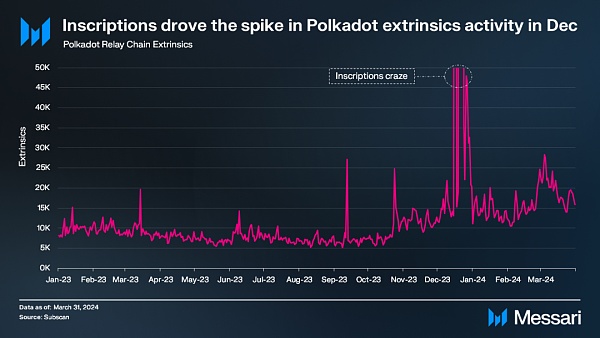
In Polkadot's blockchain framework, Extrinsic is the key factor that drives state transitions within the relay chain. It acts as a general transaction that encapsulates external data that the network needs to verify and track. Typically, extrinsics carry signatures and references to specific functions to enable interactions such as token transfers between accounts. Through extrinsics, Polkadot efficiently handles external inputs to ensure the smooth operation of its blockchain network.
From December 20-23, Polkadot saw a surge in exons due to Polkadot inscription. During this period, the Polkadot relay chain processed an average of 4.3 million exons per day. The Polkadot network successfully handled this short-term influx without degrading performance. Excluding these dates, the average daily exons still increased by 100% from the previous quarter to 17,000 million. In Q1 2024, daily exons were flat month-over-month compared to the past Q4 2023.
Development:
Has one of the largest developer bases in the crypto industry
Polkadot has one of the largest developer bases in the crypto industry.According to Electric Capital, in December 2023, the average total number of developers on Polkadot was close to 2,100, of which 792 were full-time developers, second only to Ethereum.
Polkadot provides comprehensive development support through its open source technology stack, covering all aspects of the user interface, tools, APIs and languages, smart contracts, chains and pallets, network maintenance tools, consensus, and networks.
Q1 2024 highlights include:
Polkadot Blockchain Academy (https://polkadot.network/blog/polkadot-blockchain-academy-meeting-the-needs-of-builders-and-founders-alike) further expansion, including new founder growth program and growth plans in APAC, remote options (https://polkadot.network/blog/polkadot-blockchain-academy-remote-learning-developers).
Polkadot Alpha Program(https://polkadot.network/blog/the-polkadot-alpha-program-a-new-era-for-decentralized-building-collaboration)is designed to support developers throughout their development lifecycle, including Agile Coretime.
Dune Analytics(https://polkadot.network/blog/polkadot-kusama-analytics-dune)integrates Polkadot and Kusama data.
The Web3 Foundation will shut down the W3F registered trademarks for Polkadot and Kusama.
The Web3 Foundation has provided a grant to Decentered Studio for event production and community collaboration.
Polkadot launched a new SDK for the gaming industry - Polkadot Play (https://x.com/Polkadot/status/1770135904901824937?s=20)
In addition, Polkadot founder Gavin Wood released a gray paper to introduce the JAM chain, outlining a scalable and trustless virtual machine that merges the features of Ethereum and Polkadot, combined with a global single-instance environment and cross-node secure computing, which can improve scalability and operational performance and meet compatibility requirements.
Decentralization and Security:
The validator reward model is adopted by multiple entities
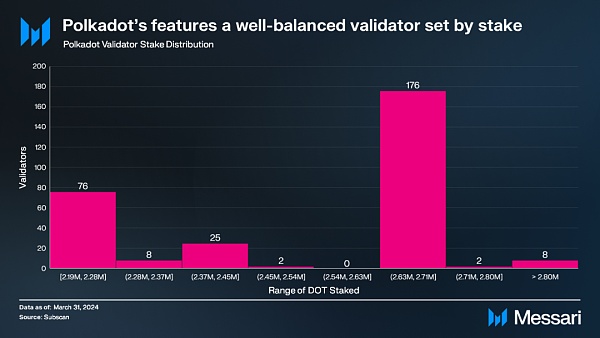
Polkadot uses a unique consensus mechanism called Nominated Proof of Stake (NPoS).Validators receive payments every 24 hours based on the payable actions they complete, called era points. Every four hours, a subset of validators are randomly selected to validate all parachains and a multiplier is applied to their era points.This combination of era points and random parachain validation creates a probabilistic guarantee of nearly identical rewards. Because validators receive nearly equal rewards and distribute those rewards proportionally to their nominators, nominators have an incentive to stake with validators with less stake to receive higher rewards. The validator nominator reward model is designed to make Polkadot's validator set more decentralized.
For many years, the set of active validators on Polkadot has remained stable at 297, with no immediate plans to change. In Q1 2024, the validator reward model continued to demonstrate its effectiveness in promoting decentralization of validator staking. Of the 297 validators, 289 have staked between 2.19 million and 2.8 million DOT. The even reward distribution of the validator model encourages node operators to operate multiple validators. This strategy has been adopted by multiple entities.
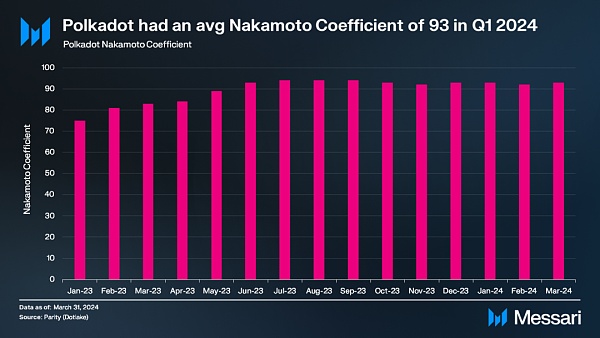
Nakamoto Coefficient refers to the minimum number of entities required to control a significant portion of the network. For PoS blockchains, this threshold is associated with control of more than 33% of the total stake.Polkadot's validator model resulted in a Nakamoto Coefficient of 93 in Q1 2024, higher than other major blockchain networks.
Governance: Rapid Growth in Proposal Participation
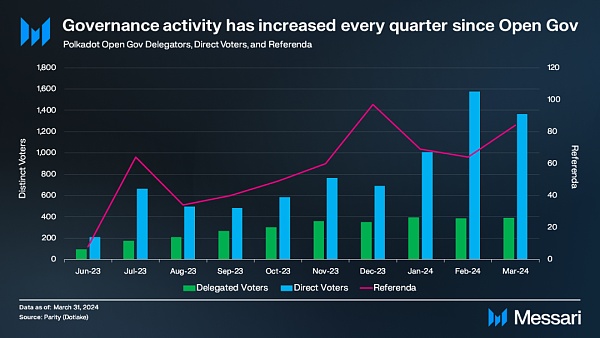
Polkadot's new governance model OpenGov, launched in the second quarter of 2023, changes the referendum life cycle and decentralized decision-making process. The system includes a bootstrap period for proposal submission, a decision period for voting and approval, and an implementation period for execution. OpenGov allows multiple referendums to be held simultaneously, speeding up the passage of motions. The Council and Technical Committee were replaced by Fellowship, which acts as a developer DAO, ensuring decentralization through flexible delegation of community voting, checks and balances, conviction, and token commitments.
After the launch of OpenGov, the amount of governance activity in the Polkadot ecosystem has increased significantly. The number of referendums, representatives, and direct voters has increased for three consecutive quarters, demonstrating the real impact of the system on governance participation. Specifically, referendums increased to 217, a 5% increase from the previous month, and a 57% increase in the past six months.
Ecosystem Analysis
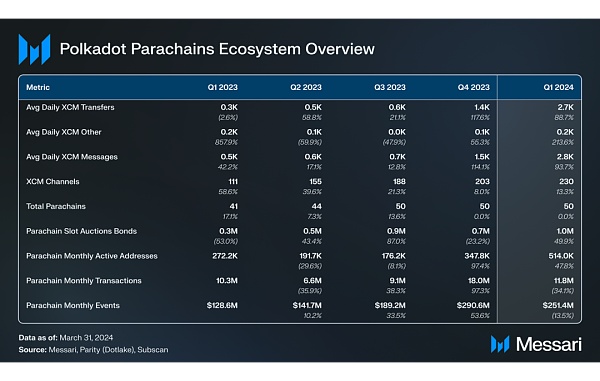
XCM:
The number of active channels continues to increase
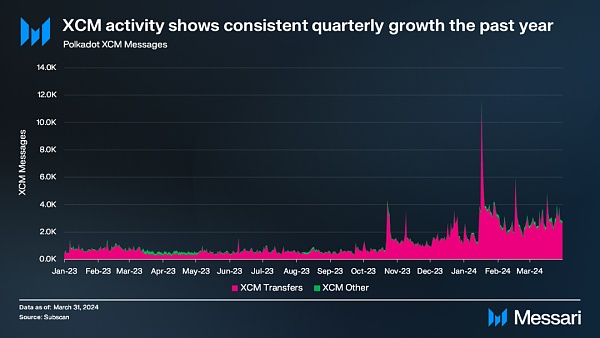
Cross-chain Message Format (XCM) is a standardized message format and language that enables seamless communication between cross-chain and other consensus-driven systems. XCM plays a key role in facilitating interoperability and complex cross-chain interactions. It allows multiple uses such as exchanging messages, performing operations, and transferring assets between blockchains.
In Q1 2024, Polkadot’s XCM activity continued to increase, with daily XCM transfers reaching 2,700, showing an 89% increase from the previous quarter, and non-asset transfer use cases known as “XCM other” increasing to 185 per day, a 214% increase from the previous quarter. The total number of daily XCM cross-chain message consensus was 2,800, up 94% from Q3 2023, achieving the goal of 314% growth. The number of active XCM channels grew to 230, indicating a 13% increase from the previous quarter.
Parallelchains:
AI protocols lead the way
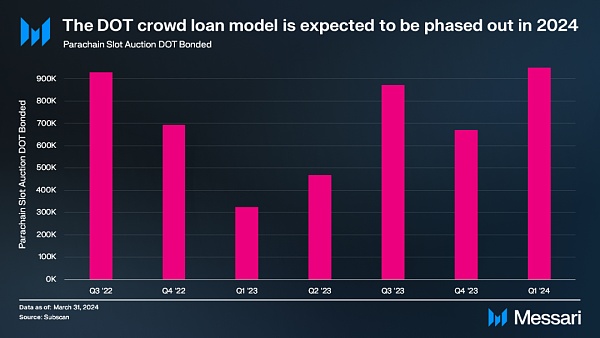
In Q1 2024, Polkadot conducted eight additional parachain auctions, bringing the total to 66. The auctions resulted in 1 million DOTs staked, the highest amount since Q2 2022. Five of the eight auctions were renewals for
Darwinia, Bifrost, Unique Network, Litentry, andNeuroWeb (formerly Origin Trail). The other three slots are allocated to new parachains:
SORA: a non-debt-based token framework that uses crypto to promote global financial stability and inclusion;
Mandala: a hybrid Layer1 blockchain that bridges the gap between emerging global blockchain markets, starting in Indonesia; and
Hyperbridge: an interoperable coprocessor.
As part of Polkadot 2.0, the parachain auction and general model will be overhauled. It introduces a market for allocating “Core time” via NFTs, allowing for more agile and on-demand access to resources. The new approach aims to address current pain points and encourage seamless application deployment and collaboration between chains. This shift will transform the Polkadot ecosystem from being “chain-centric” to being “application-centric.”

In Q1 2024, parachain active addresses reached an all-time high of 514,000, up 48% QoQ. Moonbeam maintained its position as the top parachain with 217,000 monthly active addresses (+110% QoQ). Nodle followed closely with 54,000 monthly active addresses, doubling from the previous quarter; Astar grew slightly to 26,000 (+8% QoQ), and Bifrost Finance active addresses increased to 10,000 (+2% QoQ). Acala monthly active addresses fell to 13,000 (-16% QoQ).
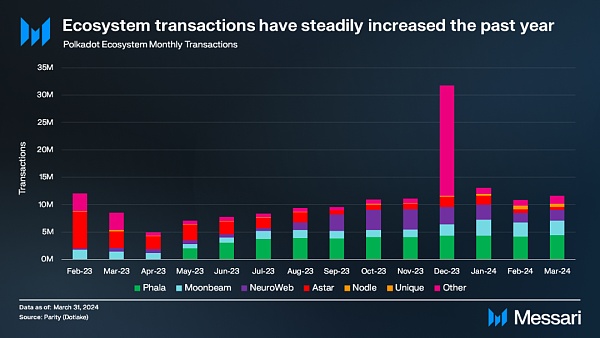
In Q1 2024, the average parachain transaction volume was 11.8 million per month, down 34% QoQ due to an abnormal spike in DOT cancellations for the first batch of parachains in Q4 2023; compared with Q3 2023, the transaction volume increased by 30%. The leading parachain Phala Network reported 4.3 million transactions per month, up 3% QoQ. Moonbeam transaction volume surges to 2.7M (+71% MoM); NeuroWeb monthly transactions fall to 2.1M (-38% MoM), and Astar monthly transactions fall to 940K (-27% MoM).
Other updates include:
Composable’s Liquid Staked DOT (lsDOT) is now live; lsdDOT will soon be integrated into their upcoming Restaking Layer.
Picasso Network integrates IBC with Ethereum, enabling asset and data transfer across the Cosmos, Kusama, and Polkadot ecosystems.
DED Game launches a promotional brick-breaking game and a $1 million marketing campaign.
Polkadot publishes blog highlighting the leading AI protocols in the ecosystem, including NeuroWeb, a decentralized knowledge graph, Phala Network, a decentralized computing network, and Bittensor, a comprehensive AI development network.
Roadmap:
Elastic Scaling and JAM ChainBecome New Hotspots in the Polkadot Ecosystem in 2024
Polkadot has completed and shared the official release of Polkadot 1.0, marking the completion of the Polkadot white paper. In addition, the network's codebase has been fully transitioned to a community-managed repository through Polkadot OpenGov and the Technical Fellowship.
The next version, Polkadot 2.0, determined by the community, will be determined through community discussion and consensus. Polkadot founder Gavin Wood proposed ideas such as "adding more flexible and capital-efficient mechanisms beyond the mechanism for allocating Polkadot block space, going beyond the parachain model, and creating selective 'accords' between multiple blockchains."
In addition, in his annual year-end review, Gavin Wood listed Parity's core technology priorities. These priorities include Agile Coretime, On-Demand Parachains, Ethereum Snowbridge, and Kusama bridge. He also introduced new technologies - Elastic Scaling and JAM Chain, which are expected to be launched in 2024. In addition, extensions of DAO primitives, including new Fellowships, multi-asset sub-libraries, extended XCM, and development of new primitives are underway. Sassafras, a forkless block generation consensus algorithm, has been developed and will be tested in 2024. Parity Labs is actively working on a variety of new technologies, including CoreJam, as they continue to shape the decentralized future of the network.
Conclusion
Polkadot starts 2024 with a strong performance from the previous year. In Q1 2024, ecosystem active addresses reached an all-time high of 514,000, up 48% month-over-month and 192% from six months ago. Moonbeam remains the leading parachain, with XCM cross-chain message consensus reaching an all-time high, up 94% month-over-month and 314% from six months ago.
Other notable announcements include the introduction of the Join-Accumulate Machine (JAM), a trustless virtual machine from Ethereum and Polkadot, referendum 457 seeking to diversify the Polkadot treasury with USDT and USDC and allow for stablecoin-denominated treasuries, and Picasso integrating IBC with the ecosystem.
Looking ahead, the Polkadot community is poised to further shape Polkadot 2.0, with the development of technologies such as Agile Coretime, On-Demand Parachains, and Elastic Scaling set to enable further growth and innovation. With a strong developer community and a rich and diverse ecosystem that continues to push the boundaries of blockchain technology, Polkadot is poised for a promising year.
 JinseFinance
JinseFinance




















